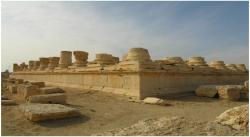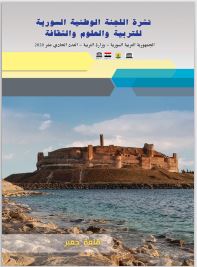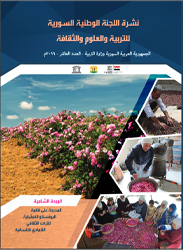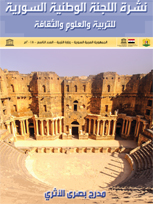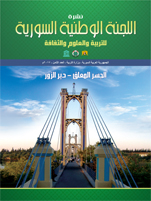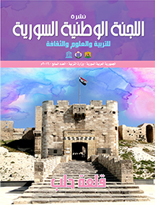Palmyra
|
- An oasis in the Syrian desert, north-east of Damascus, Palmyra contains the monumental ruins of a great city that was one of the most important cultural centres of the ancient world. From the 1st to the 2nd century, the art and architecture of Palmyra, standing at the crossroads of several civilizations, married Graeco-Roman techniques with local traditions and Persian influences.
- An oasis in the Syrian desert, north-east of Damascus, Palmyra contains the monumental ruins of a great city that was one of the most important cultural centres of the ancient world. From the 1st to the 2nd century, the art and architecture of Palmyra, standing at the crossroads of several civilizations, married Graeco-Roman techniques with local traditions and Persian influences. - First mentioned in the archives of Mari in the 2nd millennium BC, Palmyra was an established caravan oasis when it came under Roman control in the mid-first century AD as part of the Roman province of Syria. It grew steadily in importance as a city on the trade route linking Persia, India and China with the Roman Empire, marking the crossroads of several civilisations in the ancient world. A grand, colonnaded street of 1100 metres' length forms the monumental axis of the city, which together with secondary colonnaded cross streets links the major public monuments including the Temple of Ba'al, Diocletian's Camp, the Agora, Theatre, other temples and urban quarters. - Architectural ornament including unique examples of funerary sculpture unites the forms of Greco-roman art with indigenous elements and Persian influences in a strongly original style. Outside the city's walls are remains of a Roman aqueduct and immense necropolises. - Discovery of the ruined city by travellers in the 17th and 18th centuries resulted in its subsequent influence on architectural styles. Criterion (i): The splendour of the ruins of Palmyra, rising out of the Syrian desert north-east of Damascus is testament to the unique aesthetic achievement of a wealthy caravan oasis intermittently under the rule of Rome from the Ier to the 3rd century AD. The grand colonnade constitutes a characteristic example of a type of structure which represents a major artistic development. - Criterion (ii): Recognition of the splendour of the ruins of Palmyra by travellers in the 17th and 18th centuries contributed greatly to the subsequent revival of classical architectural styles and urban design in the West. - Criterion (iv): The grand monumental colonnaded street, open in the centre with covered side passages, and subsidiary cross streets of similar design together with the major public buildings, form an outstanding illustration of architecture and urban layout at the peak of Rome's expansion in and engagement with the East. The great temple of Ba'al is considered one of the most important religious buildings of the 1st century AD in the East and of unique design. The carved sculptural treatment of the monumental archway through which the city is approached from the great temple is an outstanding example of Palmyrene art. The large scale funerary monuments outside the city walls in the area known as the Valley of the Tombs display distinctive decoration and construction methods. Integrity (2009) - All the key attributes, including the main colonnaded street, major public buildings and funerary monuments, lie within the boundary. The tower tombs and the citadel are vulnerable to minor earthquakes and lack of conservation. Since the time of inscription, the population of the adjacent town has increased and is encroaching on the archaeological zone. Although traffic has increased, the main road that passed through the site has been diverted. Increased tourism has brought pressure for facilities within the property. Authenticity (2009) - The key attributes display well their grandeur and splendour. However the setting is vulnerable to the encroachment of the adjacent town that could impact adversely on the way the ruins are perceived as an oasis closely related to their desert surroundings. Protection and management requirements (2009) - The site was designated a national monument and is now protected by the National Antiquities law 222 as amended in 1999. A buffer zone was established in 2007 but has not yet been submitted to the World Heritage Committee. The regional strategic action plan currently under preparation is expected to provide guidelines to expand and redefine the site as a cultural landscape, with respect to the transitional zones around the archaeological site, the oasis and the city. - There is an on-going need for a conservation and restoration plan to be developed that addresses fully the complex issues associated with this extensive multiple site and will allow for coordinated management, clear priorities and a cultural tourism strategy and address the issues of expansion of the nearby town. Long Description - Palmyra exerted a decisive influence on the evolution of neoclassical architecture and modern urbanization.The city offers the consummate example of an ancient urbanized complex, for the most part protected, with its large public monuments such as the Agora, the Theatre and the temples. Alongside these, the inhabited quarters are preserved, and there are immense cemeteries outside the fortified enceinte. Palmyran art, for which the great museums of the world now vie, unites the forms of Graeco-Roman art with indigenous elements and Iranian influences in a strongly original style. As the crossroads of several civilizations, it is here that unique creations came into existence, notably in the domain of funerary sculpture. - Since prehistory there has been human settlement in this area, from the Palaeolithic and Neolithic eras. Palmyra is a fertile oasis located close to a mountainous passage, in the heart of the Syrian desert. It developed into a staging post between Al-Shaam and Iraq, the Arab Gulf and Persia and the Mediterranean. It was to the exploitation of this rich caravan trade that the city owed its prosperity and importance. Palmyra established itself as the most important market for Eastern products and the leading caravan city of the Roman Empire, taking over a role that had previously been performed by Petra. This began when the emperor Trajan in AD 105-6 incorporated it into the new province of Arabia, following the annexation of Nabatea, a client state that controlled much of the trade with the East. - During the 3rd century AD, with the accession of the Sassanid dynasty to the Parthian throne and the resulting resumption of hostilities against the Romans, Palmyra also assumed an important strategic and military role: the nobleman Septimius Odaenathus obtained support and recognition from Rome, as an ally in their struggle against the Sassanids. When the Emperor Valerian was defeated and captured by the King of the Parthians, Odaenathus took a stand in defence of the empire and Valerian's son, Gallienus, winning a series of military victories. He was succeeded on the throne by his younger son from his second marriage, Wahballath, under the regency of his mother Zenobia, who invited to her court as her son's preceptor Cassius Longinus. She conquered all of Syria and extended her dominion as far as Egypt and Anatolia. Palmyra, which was spared at first, made an attempt at rebellion but was quickly sacked and plundered, and the city walls were destroyed. It was the beginning of the city's decline, but the myth of the queen of Palmyra, Zenobia, was not destroyed. She was the incarnation of the finest male and female virtues, which were to outlive the collapse of the ancient world. - Palmyra was a wealthy caravan centre from 44 BC to AD 272, alternately independent from and under the rule of Rome, which during the 2nd and 3rd centuries was richly embellished. The grand colonnade, 1,100 m in length, which links the temple of Bel with the so-called Camp of Diocletian, is the monumental axis of the city, with its open central street flanked by covered lateral passages. The principle of the colonnaded portico is to be found in the secondary axes, which run perpendicular to the grand colonnade, and certain of these date back to the 2nd century. The colonnade is not perspectival in its progress: the two areas are not aligned with each other, and so it takes a sharp turn before straightening out again at the three-arched Triumphal arch dating from the Severan period, only to undergo a further adjustment to align itself with the so-called Tetrapyle, two pairs of floral columns symmetrically arranged on tall monumental bases. The temple proper, built in AD 32, stood at the centre of a sacred precinct which was later bounded by a broad porticoed peribolos with a double order of columns on the interior, punctuated on the exterior by elegant Corinthian pilaster strips. - Outside the inhabited town, along the four main access roads to the city, stood four cemeteries, which feature three types of tomb. The oldest and most distinctive group is represented by the funerary towers, tall multi-storey sandstone buildings belonging to the richest families. On the fronts of those that survive, foremost among them the Tower of Elahbel, there is an arch with sarcophagus halfway up, which in ancient times supported a reclining statue. Corridors and rooms were subdivided by vertical bays of loculi, closed by slabs of stone carved with the image of the deceased and painted in lively colours. |
View Album / Palmyra











